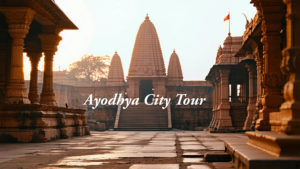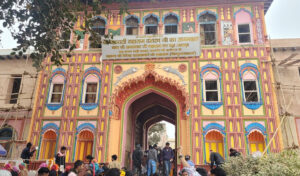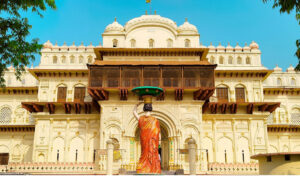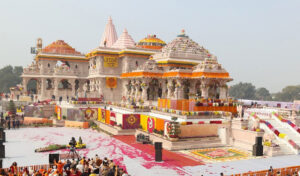Gupt Hari Ghat, Ayodhya – The Hidden Riverside Sanctuary

When you think of Ayodhya sightseeing places, big-name temples and ghats often come to mind—but tucked away on the banks of the sacred Sarayu River lies Gupt Hari Ghat (also called Guptar Ghat), a peaceful, myth-steeped tourist spot in Ayodhya that many travellers miss. For anyone wanting to explore beyond the crowds, this is a must-visit place in Ayodhya—quiet yet soul-stirring, simple yet spiritually profound.
Where Is Gupt Hari Ghat?
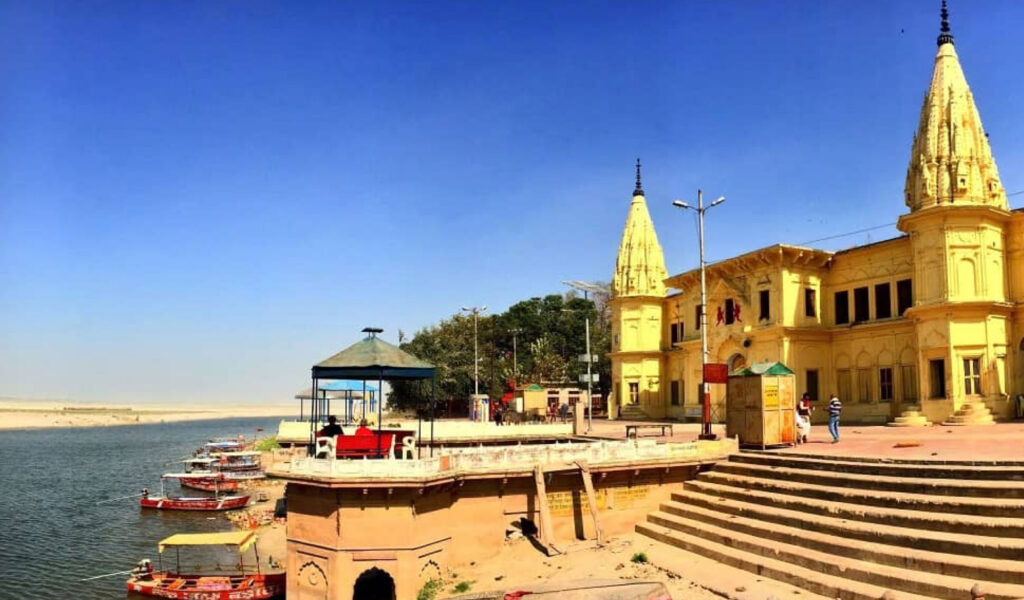
Gupt Hari Ghat (also known as Guptar Ghat) is beautifully situated on the west bank of the sacred River Sarayu (Ghaghra) in Ayodhya, Uttar Pradesh. It lies about 10 kilometres from Ayodhya Junction railway station, making it easily reachable by car, taxi, or even auto-rickshaw. Unlike the bustling lanes around Ram Janmabhoomi and Hanuman Garhi, this ghat is tucked away in a calmer part of the city, offering visitors a more relaxed experience.
Because of its location away from the temple-heavy city centre, Gupt Hari Ghat is often included in Ayodhya sightseeing itineraries for those who want to balance popular attractions with quieter, lesser-known gems. Pilgrims and travellers use it as a stop on Ayodhya’s river-ghat circuit and pilgrimage parikrama routes, which traditionally include multiple ghats along the Sarayu. The ghat is also part of the area once known as Company Gardens during the British era, adding layers of history alongside its spiritual importance.
Today, Gupt Hari Ghat stands as one of the most meaningful yet peaceful Ayodhya tourist spots—easy to reach, blessed with natural riverfront charm, and deeply tied to Lord Rama’s story.
Mythological & Historical Significance of Gupt Hari Ghat

What makes Gupt Hari Ghat one of the most revered yet serene Ayodhya tourist attractions is the way myth and history seamlessly intertwine here.
1. Lord Rama’s Jal Samadhi
According to Hindu belief, Gupt Hari Ghat is the sacred site where Lord Rama performed Jal Samadhi. After fulfilling his duties as king, Rama is said to have immersed himself in the waters of the Sarayu River, ending his earthly incarnation and returning to his eternal abode in Vaikuntha. For devotees, this act marks not just a physical departure but a divine transition, making Guptar Ghat one of the holiest places to visit in Ayodhya for those seeking spiritual depth and connection to Rama’s final moments on earth.
2. The Company Gardens Legacy
During the colonial era, the ghats and their surrounding gardens were part of the Company Gardens, later renamed Guptar Ghat Van. This gives the site an added layer of historical and cultural significance, blending natural beauty with traces of India’s colonial past. The gardens provided a green retreat, and even today the leafy surroundings and botanical charm offer a sense of serenity rarely found in Ayodhya’s busier temple areas.
3. Temples & Shrines Along the Ghat
The ghat is lined with both ancient and more recent temples, each adding a unique facet to its sacred aura. Notable among them are:
•Sita-Ram Temple – dedicated to Rama and Sita, reinforcing the divine couple’s central role in Ayodhya’s spiritual geography.
•Narsingh Temple – honoring Lord Vishnu in his fierce Narasimha avatar.
•Chakrahari Shrine – another sacred stop for devotees, tying in strands of Vaishnavite devotion.
These temples not only enrich the devotional atmosphere but also connect visitors to Ramayana legends, local folklore, and centuries of worship traditions, making Guptar Ghat a living museum of Ayodhya’s layered religious heritage.
In essence, Gupt Hari Ghat is more than just a riverside—it’s a symbol of Rama’s eternal departure, a colonial-era heritage site, and a devotional hub, all of which make it one of the most profound Ayodhya places to see for pilgrims and heritage travellers alike.
Architecture of Guptar Ghat (Gupt Hari Ghat)
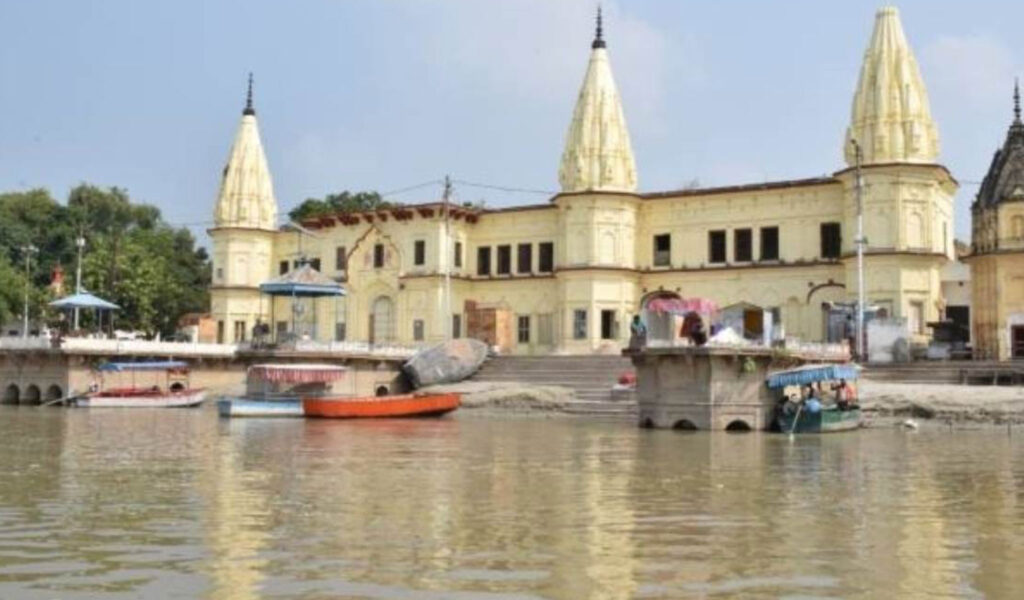
Guptar Ghat combines colonial-era design with devotional architecture. The ghats here were once part of the Company Gardens during British rule, hence they feature broad steps, shaded trees, and garden-style layouts. Along the ghat stand several temples and shrines such as the Sita-Ram Mandir and Narsingh Temple, each constructed in traditional styles with domes, carved spires, and colourful facades. The ghats themselves are stone-paved, leading directly into the Sarayu River, where devotees take holy dips. The combination of botanical surroundings and religious shrines makes Guptar Ghat a blend of natural and architectural beauty.
What You’ll See & Do at Gupt Hari Ghat
When you visit as part of your Ayodhya sightseeing tour, here are the experiences you shouldn’t miss:
1.Ghat & Riverfront Steps – A flight of steps leads down to the Sarayu. You can sit, meditate, or simply watch pilgrims taking holy dips. The serene river views at dawn or dusk are especially exquisite.
2.Boating / Riverside Calm – Gentle boat rides are offered on the Sarayu, letting you see Ayodhya’s ghats from water and enjoy a peaceful perspective.
3.Temples & Shrines – Explore the Sita-Ram Temple, Narsingh Temple, Chakrahari Shrine (and possibly others like Charan Paduka). These are small yet meaningful, and give context to the pilgrimage stories.
4.Meditation & Reflection – Because the place is less crowded than the central Ayodhya ghats, Guptar Ghat offers a calm atmosphere to reflect, pray or simply soak in the environment. The sound of water, the call of birds, and the open sky make this a perfect spiritual pause.
5.Sunrise / Sunset Views – The riverside location makes for beautiful lighting at sunrise or sunset, ideal for photography, quiet walks, or devotional moments.
Best Time to Visit & Travel Tips
• Best Seasons: October to March is ideal—more pleasant temperatures, clearer skies. Summers can be hot and humid by the river.
•Best Time of Day: Early morning or late evening — to avoid crowds and enjoy cooler, softer light.
•What to Bring: Modest clothing (as this is a sacred site), water bottle, sun protection, comfortable shoes. If you plan to bathe, bring a towel and extra clothes.
•Facilities: No entry fee. Ghat is open all day. Some basic amenities (steps, temples, rest areas) are present. Be prepared for fewer shops nearby and limited commercial infrastructure.
Why Gupt Hari Ghat Should Be On Your Ayodhya Travel List
Gupt Hari Ghat may lack the scale of big temples, but it makes up for this with spirituality, solitude, and stories. It gives you a less commercialized taste of Ayodhya—one that emphasizes quiet devotion, mythic endings, and riverside beauty. For travellers wishing to see Ayodhya tourist attractions beyond the usual, and for those looking to balance their visit with reflection rather than only ritual, this ghat is perfect.
How to Reach Gupt Hari Ghat (Guptar Ghat)
By Road: Gupt Hari Ghat is about 9–10 km from Ayodhya Junction Railway Station. You can take a taxi, auto-rickshaw, or private car. The ride takes around 20–30 minutes depending on traffic. Roads are fairly good, and it’s an easy drive along the Sarayu river stretch.
•By Rail: The nearest station is Ayodhya Junction (AY). From the station, you’ll need to hire a taxi or auto to reach the ghat.
•By Air: The nearest airport is Maharishi Valmiki International Airport, Ayodhya, around 15–18 km from the ghat. From the airport, you can book a cab directly to Guptar Ghat. Alternatively, Lucknow’s Chaudhary Charan Singh Airport (~135 km away) is another major option.
Nearby Places to Visit Along with Gupt Hari Ghat
When visiting this peaceful Ayodhya tourist spot, you can also explore these nearby attractions:
•Company Garden (Guptar Ghat Van) – Adjacent to the ghat, offering greenery and calm walks.
•Sita-Ram Temple – On the ghat itself, dedicated to Lord Rama and Sita.
•Narsingh Temple – Another shrine close to the ghat, dedicated to Lord Vishnu’s Narasimha avatar.
•Chakrahari Shrine – Small but significant temple near the ghat.
•Ram Ki Paidi (Saryu Ghats) – Around 10 km away, these ghats are famous for evening aarti and pilgrim activity.
•Hanuman Garhi – A popular hilltop temple in Ayodhya city (~9 km).
•Kanak Bhawan – Beautiful temple dedicated to Lord Rama and Sita (~10 km).
•Ram Janmabhoomi Temple – The most iconic pilgrimage site in Ayodhya (~10 km).
Together, these make a perfect Ayodhya sightseeing itinerary, mixing both famous landmarks and quieter gems like Gupt Hari Ghat.
Suggested Itinerary Including Gupt Hari Ghat
Here’s how you can include Gupt Hari Ghat in your full-day Ayodhya sightseeing plan:
•Morning: Start at Ram Janmabhoomi → Kanak Bhawan → Hanuman Garhi
•Late Morning: Drive to Gupt Hari Ghat → spend time at the riverfront, take a boat ride, visit temples
•Afternoon: Lunch in Ayodhya city centre → relax/rest
•Evening: Return to Gupt Hari Ghat for sunset or go to the Saryu Ghats (Ram Ki Paidi) for evening aarti
Frequently Asked Questions (FAQ) about Gupt Hari Ghat
1. What is Gupt Hari Ghat (Guptar Ghat)?
Guptar Ghat is a sacred river-ghat on the banks of the Sarayu River in Ayodhya. It is believed to be the place where Lord Rama performed Jal Samadhi—immersing himself in the river to return to his divine abode.
2.How far is Guptar Ghat from Ayodhya city centre / railway station?
It’s about 9-10 km from Ayodhya Junction / Ayodhya Railway Station. Some sources say about 9 km from Hanuman Garhi.
3.Is there an entry fee to visit Guptar Ghat?
No, there is no entry fee. The ghat is open to the public freely.
4.What are the visiting hours / Is it open all day?
Guptar Ghat is open 24 hours. You can visit at any time, though early morning and evening are more peaceful and recommended.
5.What is the mythological or spiritual significance of the ghat?
•It is believed to be the site of Lord Rama’s Jal Samadhi, where he left his earthly life and returned to Vaikuntha.
•The ghat has been mentioned in scriptures and folk traditions; it’s connected with rituals and pilgrimage practices.
6.What can visitors expect to see / do at Guptar Ghat?
•Steps/ghats leading down to the Sarayu River for bathing and rituals.
•Temples nearby: Sita-Ram Temple, Narsingh Temple, Chakrahari Shrine etc.
•Beautiful riverside views, sunrise/sunset, calm atmosphere, devotional chants, and possibly boat rides.
7.Is it safe / allowed to take a holy dip in the Sarayu River at Guptar Ghat?
Yes, devotees do take holy dips. It is a common religious practice there. But as with any river bathing, one should take care regarding water currents, cleanliness, and safety.
8.What facilities / amenities are near Guptar Ghat?
Basic facilities are available — ghats/steps, seating, walkways, rest areas. Some restoration efforts have added better amenities. However, shops/restaurants might be limited. Carry water, basic supplies.
9.What is the best time of day or year to visit Guptar Ghat?
•Time of day: Early morning or evening to enjoy peace, cooler temperatures, and beautiful light for photography.
•Time of year: Winters (November-February) are ideal because weather is pleasant. Avoid very hot summer afternoons.
10.How long should one plan to spend at Guptar Ghat?
Usually 1-2 hours are enough to explore, do rituals, enjoy the riverfront, view nearby temples. If combining with other nearby sightseeing, allow more time.
11.Are there guided tours / how to reach Guptar Ghat?
•You can reach by taxi / auto from Ayodhya city.
•Some tours of Ayodhya include Guptar Ghat as part of the circuit.
12.Is photography allowed?
Yes — public views, ghats and temples are generally photo-friendly. Be respectful during rituals. (No specific policy found restricting photography in sources.)
13.Any dress code?
Visitors are expected to dress modestly, as is customary at religious places in India. (Not always explicitly stated but implied in travel guides.)
14.Is Guptar Ghat crowded / are there particular days when crowds are larger?
•Yes, during festivals and religious occasions the ghat sees more devotees.
•Mornings and evenings are usually less crowded.
15.Is there any significance for festivals at Guptar Ghat?
Yes — special observances, rituals, more devotees come during festival days like Kartik Purnima and other important dates in Hindu calendar.
16. Can I visit Gupt Hari Ghat safely for a dip/bath during an Ayodhya pilgrimage?
Yes, many people do take holy dips there. It is considered safe for ritual bathing. However, as with any river site, caution is advised—especially if there are strong currents, after rains, or during monsoon. Also check water cleanliness and weather conditions.
17. What are the best times for photography at Gupt Hari Ghat?
Early morning (around sunrise) and late afternoon/evening (sunset) are ideal. The lighting is soft, the river’s reflections are beautiful, and there are fewer crowds then. Also, after restoration works (if any), ornamental pillars and landscaped paths make good photo-subjects.
18. Is there public transport to Gupt Hari Ghat from Ayodhya city?
There is usually taxi or auto-rickshaw access from Ayodhya city center. Depending on your location, you might also hire private vehicles. Public buses may not go exactly up to the ghat, so confirm locally. Road connectivity is decent.
19. Are there guides available at Gupt Hari Ghat to explain its myth and history?
Sometimes local priests or guides are available (especially during busy pilgrimage periods) who can narrate the stories, legends, and significance of Gupt Hari Ghat. If you want detailed historical input, consider hiring a local certified tour guide in Ayodhya.
20. What should one avoid doing at Gupt Hari Ghat to respect local customs?
Modest dress is expected (covering shoulders, knees). Avoid loud music or behavior during rituals. Follow signs regarding where photography is allowed. Do not pollute the river — avoid littering and be mindful of offerings and waste.
21. Is the water quality good for bathing at Gupt Hari Ghat?
The water quality can vary. While many people bathe there as part of ritual, it’s wise to check recent local reports or ask locals about condition. Avoid bathing after heavy rains or floods, when the river may be contaminated.

